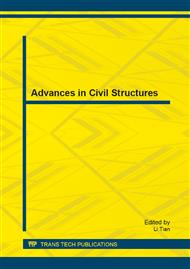[1]
DIN18800- II Structural steel work (Deulsches institut für Normung e.V., Berlin, 1990).
Google Scholar
[2]
Technical specification for steel arch structure (China Planning Press, Beijing, 2002). (In Chinese).
Google Scholar
[3]
Haifan Xiang: Stability and Vibration of arch structure (China Communications Press, Beijing , 1991). (In Chinese).
Google Scholar
[4]
Papangelis J. P, Trahair N. S: Journal of Structural Engineering, Vol. 113, No. 4, (1987), pp.889-906.
Google Scholar
[5]
Trahair N. S, Papangelis J. P: Journal of Structural Engineering, Vol. 113, No. 10, (1987), pp.2271-2289.
Google Scholar
[6]
Yonghua Yang, Yiyi Chen: Engineering Mechanics, Vol. 25, No. 4, (2008), pp.1-4, 20. (In Chinese).
Google Scholar
[7]
Yonghua Yang, Jie Wu: Engineering Mechanics, Vol. 29, No. 3, (2012), pp.27-32. (In Chinese).
Google Scholar
[8]
Caihong Qiao, Yanlin Guo: Industrial Construction, Vol. 39, No. 12, (2009), pp.90-94. (In Chinese).
Google Scholar
[9]
Sakimoto T, Komatsu S: Journal of Structural Engineering, Vol. 109, No. 3, (1983), pp.613-627.
Google Scholar
[10]
Pi Y L, Trahair N S: Journal of Structural Engineering, Vol. 124, No. 2, (1998), pp.174-183.
Google Scholar
[11]
Pi Y L, Bradford M A: Journal of Structural Engineering, Vol. 131, No. 4, (2005), pp.560-568.
Google Scholar
[12]
Chao Dou, Yanlin Guo: Journal of Building Structures, Vol. 33, No. 7, (2012), pp.18-26. (In Chinese).
Google Scholar
[13]
Chao Dou, Yanlin Guo: Engineering Mechanics, Vol. 29, No. 3, (2012), pp.83-94. (In Chinese).
Google Scholar
[14]
Chao Dou, Yanlin Guo: Journal of Building Structures, Vol. 33, No. 1, (2012), pp.104-110. (In Chinese).
Google Scholar
[15]
Yuzhen Chang, Lingling Wang: Journal of Wuhan University of Technology, Vol. 32, No. 9, (2010), pp.301-304. (In Chinese).
Google Scholar
[16]
Yuzhen Chang, Lingling Wang: Xian Univ. Arch &Tech: Natural Science Edition, Vol. 43, No. 2, (2011), pp.202-207. (In Chinese).
Google Scholar
[17]
ANSYS Inc.: ANSYS element reference (SAS IP, Inc., USA, 1998).
Google Scholar


